Sony Ericsson T100, T102 User Manual
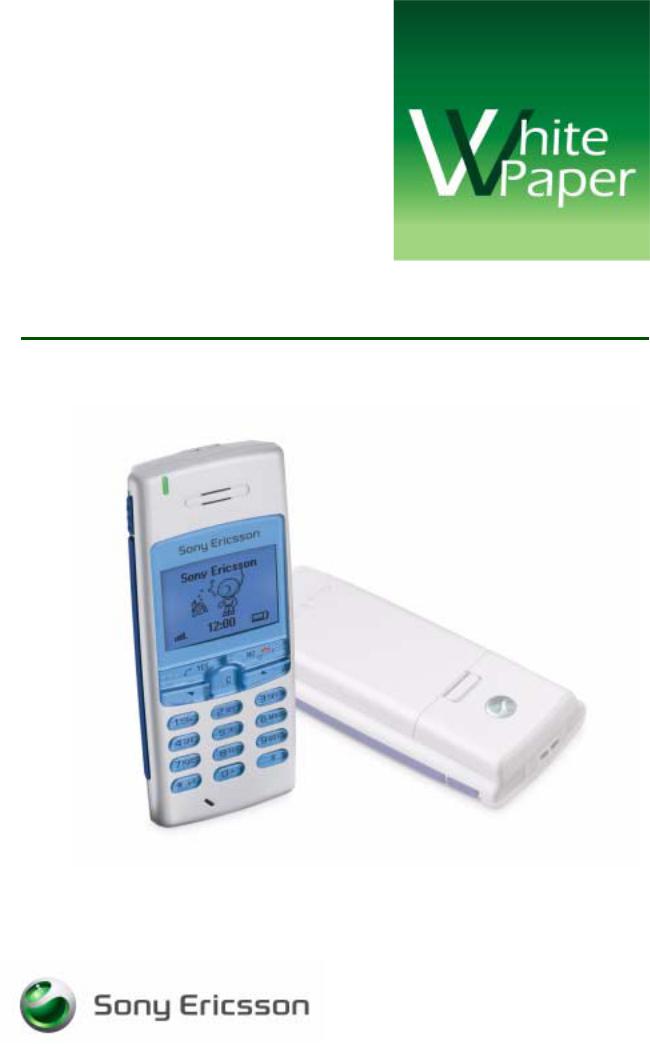
September 2002
T100/T102

White Paper T100/T102
Preface
Purpose of this document
The Sony Ericsson T100/T102 White Paper is designed to give the reader a deeper technical understanding of how the T100/T102 is designed, and of how it interacts with other media. This document will make it easier to integrate the T100/T102 with the IT and communications solutions of a company or organization.
People who can benefit from this document include:
• |
Corporate buyers |
• |
Support engineers |
• |
IT professionals |
• |
Business decision-makers |
• |
Software developers |
|
|
More information, useful for product, service and application developers, is published on the Sony Ericsson Developer World. The site at http://www.SonyEricsson.com/developer/ contains up-to-date
information about technologies, products and tools.
This White Paper is published by:
Sony Ericsson Mobile Communications
AB, SE-221 88 Lund, Sweden
Phone:+46 46 19 40 00
Fax: +46 46 19 41 00
www.SonyEricsson.com/
First edition (September 2002) Publication number: LZT 108 6034 R1B
This document is published by Sony Ericsson Mobile Communications AB, without any warranty.
Improvements and changes to this text necessitated by typographical errors, inaccuracies of current information or improvements to programs and/or equipment, may be made by Sony Ericsson Mobile Communications AB at any time and without notice. Such changes will, however, be incorporated into new editions of this document. Any hard copies of this document are to be regarded as temporary reference copies only.
2 |
September 2002 |
White Paper T100/T102
Content
Purpose of this document ......................................................................................... |
2 |
Product overview ........................................................................................................ |
5 |
Key functions and features ....................................................................................... |
6 |
Secure WAP ........................................................................................................... |
6 |
Messaging – EMS .................................................................................................. |
6 |
Picture editor ......................................................................................................... |
6 |
T9™ Text Input for quicker messaging ................................................................. |
7 |
The phone book ..................................................................................................... |
7 |
Shortcuts ............................................................................................................... |
7 |
Picture phone book - see who's calling ................................................................ |
7 |
More in-phone functions and features ...................................................................... |
8 |
Up-to-date with the calendar ................................................................................ |
8 |
Profiles ................................................................................................................... |
8 |
Option key ............................................................................................................. |
9 |
Games ................................................................................................................... |
9 |
Accessories ........................................................................................................... |
9 |
Start-up show ........................................................................................................ |
9 |
Background pictures ............................................................................................. |
9 |
Services on the network ...................................................................................... |
10 |
Dual band support ............................................................................................... |
10 |
Sleep mode .......................................................................................................... |
10 |
Ring signals ......................................................................................................... |
10 |
Technologies in detail ............................................................................................... |
11 |
Messaging ............................................................................................................... |
12 |
EMS – Enhanced text messaging ........................................................................ |
12 |
WAP services .......................................................................................................... |
13 |
Using WAP in the T100/T102 .............................................................................. |
13 |
Bearer type characteristics .................................................................................. |
14 |
Security using WAP ............................................................................................. |
15 |
Configuration of WAP settings ............................................................................ |
15 |
Push services ....................................................................................................... |
15 |
Mobile Internet ........................................................................................................ |
16 |
GSM data communication ................................................................................... |
17 |
In-phone functions and features .......................................................................... |
17 |
Network-dependent features ............................................................................... |
19 |
Facts and figures ...................................................................................................... |
20 |
SIM application toolkit ............................................................................................. |
21 |
SIM AT services supported by the T100/T102 .................................................... |
21 |
User interaction with SIM AT ............................................................................... |
23 |
Chinese versions ..................................................................................................... |
24 |
Terminology and abbreviations ............................................................................... |
25 |
Related information ................................................................................................. |
28 |
Documents .......................................................................................................... |
28 |
Links .................................................................................................................... |
28 |
Trademarks .......................................................................................................... |
28 |
Technical specifications .......................................................................................... |
28 |
General ................................................................................................................ |
28 |
3 |
September 2002 |
White Paper T100/T102
Talk and standby times ....................................................................................... |
29 |
Exterior description .............................................................................................. |
29 |
Ambient temperatures ......................................................................................... |
29 |
Standard language configurations ...................................................................... |
29 |
Speech coding ..................................................................................................... |
31 |
Performance and technical characteristics ......................................................... |
31 |
WAP browser technical data ............................................................................... |
31 |
Cell broadcast service ......................................................................................... |
32 |
Short message service ........................................................................................ |
33 |
Enhanced message service ................................................................................. |
34 |
Images – downloading to phone ......................................................................... |
35 |
Consumer pack content ...................................................................................... |
36 |
4 |
September 2002 |

White Paper T100/T102
Product overview
The T100 will attract modern young people who appreciate attractive design, ease-of-use and, core features at an affordable price. The T100 is small in size and gives a glimpse of the new industrial design that is coming from Sony Ericsson, capturing the simplicity and minimalism of Scandinavian and Japanese design. The phone features enhanced messaging capabilities and will start shipping in Q4 2002.
Developed for GSM 900/1800 networks, the T100, and T102 for Mainland China, will be available in Eastern Europe, the Middle East, Africa, Latin America and Asia/Pacific. The phone will be introduced in some Western Europe markets during Q1 2003, and during the same time period there will be a GSM 850/1900 version for Latin Americas.
5 |
September 2002 |
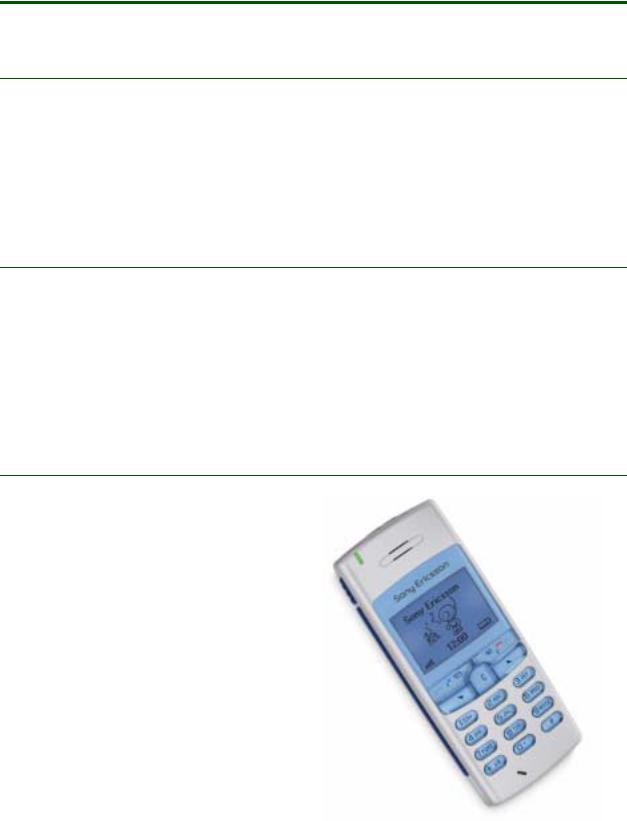
White Paper T100/T102
Key functions and features
Secure WAP
M-commerce is expected to be a growing part of the mobile Internet. Trading, banking and shopping have been possible via the Internet for quite some time, building upon the foundation of the built-in security features. It is these features that have been
adapted to and implemented in the WAP protocol and the layer called WTLS, Wireless Transport Layer Security. The T100/T102 supports WAP 1.2.1, the version of the Wireless Application Protocol that includes WTLS class 2.
Messaging – EMS
EMS (Enhanced Messaging Service) lets users send black and white pictures, animations, sound effects and ring signals to each other.
The T100/T102 also supports Nokia’s Picture Messaging by allowing the user to receive and store pictures included in messages sent from Nokia
phones. These pictures can be used as background pictures. The max size of a picture is 2847 pixels (73x39).
It is, however, not possible to send pictures and ring signals from the T100/T102 to Nokia phones.
Picture editor
The user can edit pictures and symbols directly on the phone, to create new, personal pictures for inclusion in EMS messages. The Picture Editor allows the user to view the picture in the display and edit it with the pen tool.
The available tools include:
•Set line thickness (Pen size)
•Zoom in, zoom out
•Change picture width and height
•Select black or white pen
The T100/T102 has a set of predefined pictures for use with EMS, which also can be edited. New pictures can be received with EMS messages and saved in the phone.
6 |
September 2002 |
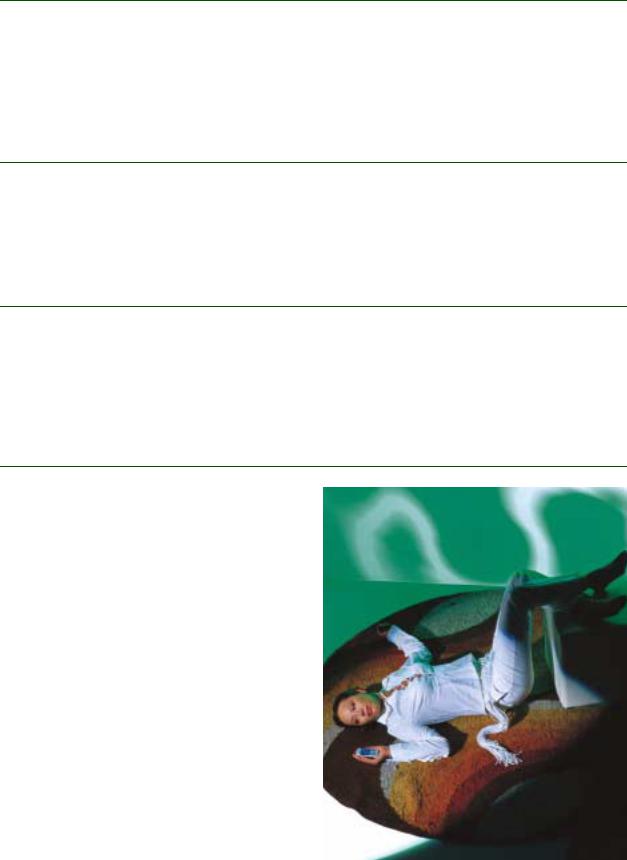
White Paper T100/T102
T9™ Text Input for quicker messaging
The T100/T102 supports the predictive text input method T9™ Text Input. Predictive text input makes it fast and easy to write text messages. It works by searching a word database to anticipate
which word you are writing. You only have to press each key once, even if the letter you want is not the first letter on the key.
The phone book
The phone book is one of the most used features of mobile phones. The phone book in the T100/T102 lets you save up to 100 contacts. An additional
number of contacts can be saved on your SIM card. How many depends on what SIM card you are using.
Shortcuts
It is easy to access the phone numbers in the phone book when you make a call. Just press and hold down the button with the letter that the name you are looking for starts with. You instantly enter
the phone book and find the first name that starts with that letter. Then you just scroll to find the name you are looking for.
Picture phone book - see who's calling
The T100/T102 lets you assign a picture or an icon stored in the phone to an entry stored in the phone book. When a person calls, a picture or an icon of your choice will be shown in the display as well as the name. It is also possible to assign a ring-signal to an entry in the phone book. When a person calls, that particular ring-signal will be heard, together with the name in the display.
The pictures used for Caller ID can be:
•Any of the EMS pictures stored in the phone from the start
•Pictures that have been received via EMS messages
•Any operator defined picture stored in My Pictures
•EMS pictures created with the Picture editor
The T100/T102 also supports name and number presentation as well as CLI restriction.
7 |
September 2002 |
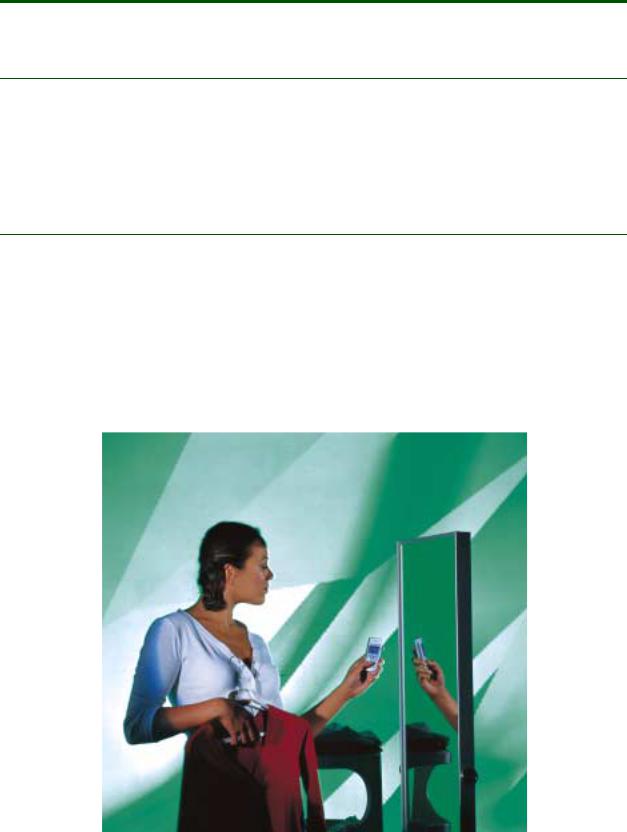
White Paper T100/T102
More in-phone functions and features
Up-to-date with the calendar
The calendar of the T100/T102 keeps the user on the right track. It has four different views: day, week, month and all tasks view.
Profiles
The profile feature: a group of settings preset to suit a certain environment. The profiles are also related to intelligent accessories such as a desktop charger or a portable handsfree; useful for company integration with call forwarding etc. Some phone accessories select a profile automatically. For example, when you attach a portable handsfree to your T100/T102, the Port h-free profile is cho-
sen. There are five pre-programmed profiles: Normal, Meeting, Outdoors, Port h-free (portable handsfree), Home.
You cannot create more profiles, but you can change the settings for a profile. A profile with no accessories associated to it, such as Meeting or Normal, must be chosen manually.
8 |
September 2002 |

White Paper T100/T102
Option key
When writing a text message, press and hold the “#” key, and a list of options is displayed. When in the WAP browser, press and hold YES, for a list of options.
Games
For some people, playing a game is a good way to |
• |
Ballpop |
relax. The T100/T102 includes the following five |
• |
Naval Fleet |
games for different moods and skills: |
• |
Q |
|
• |
Yukon Struggle |
|
• |
Wu Zi Qi |
Accessories
The T100/T102 supports various accessories, such as Portable handsfree HPE-14, Portable handsfree HPB-10, Car holder HCH-30, Car handsfree pack HCX-30 and Desk Stand CDS-11.
Start-up show
Another way to make the T100/T102 more personal is to have a user-defined start-up show. Every time the phone is turned on, an animation, with or without sound, appears in the display. There is one Sony Ericsson-defined show stored in the phone,
and there might also be one operator-defined show. As with the background picture, the userdefined show can use any of the EMS pictures stored in the phone.
Background pictures
The user can have a background picture in the display, to bring extra life to the phone when it is in standby mode. The background pictures can be one of 10 pre-defined, replaceable pictures or an operator defined picture.
9 |
September 2002 |
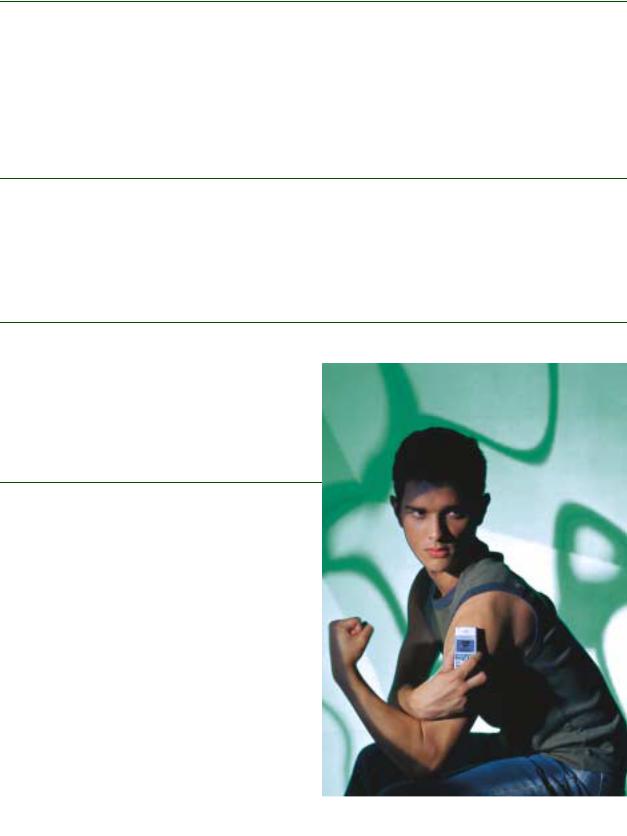
White Paper T100/T102
Services on the network
The T100/T102 supports the SIM Application Toolkit (online services), which makes it possible for operators to provide new services to existing users over the air, including new menus and functions in the phone.
Dual band support
Dual band support means that you can use the phone on two GSM networks; the T100 and T102 can be used on GSM 900 and 1800 networks.
Sleep mode
It is possible to extend the standby time in the T100/T102 by activating the sleeping mode function. This function turns off a part of the display to reduce the current consumption.
Ring signals
There are four ways to find a catchy ring signal for the T100/T102. One way is to choose any of the pre-programmed ring signals in the phone. Another way is to compose up to 10 new ring signals and choose one of them. It is also possible to download a ring signal from a WAP site or receive a catchy tune in an EMS message from a friend or a company that sells ring signals.
10 |
September 2002 |

White Paper T100/T102
Technologies in detail
The T100/T102 includes features such as Enhanced messaging, where the consumer can send messages with pictures, sounds and animations. It also supports other new technologies such as browsing over WAP. The following chapter gives a more detailed explanation of these features.
11 |
September 2002 |
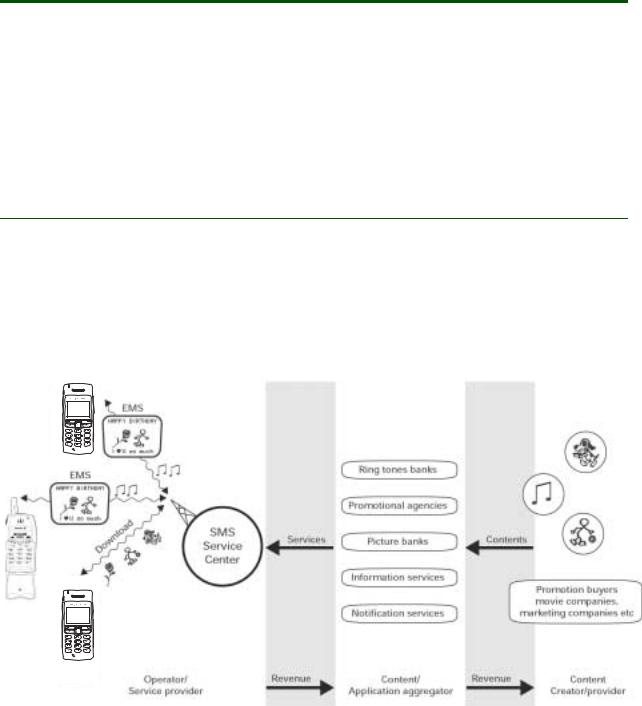
White Paper T100/T102
Messaging
More than 15 billion text messages are sent worldwide between mobile phones each month (January, 2001). The consumers’ needs to express themselves in ways beyond voice were highly underestimated by the industry when SMS was introduced in the late 90s. The success of SMS, however, is
the springboard for existing and coming messaging services, such as Enhanced Messaging Service (EMS). The added value in SMS messaging will create new revenue which can be shared between the network operators, the application aggregators and the content providers.
EMS – Enhanced text messaging
EMS lets users send black and white pictures, animations, sound effects, ring signals and formatted text to each other. EMS is based on SMS text messaging and is a GSM standard developed by 3GPP, Third Generation Partnership Programme.
Unlike Nokia's Picture Messaging, EMS works with phones that do not support EMS, simply by allowing the receiving phone to ignore the EMS items and only display the text.
Figure 1. This diagram shows a model over the possibilities with Enhanced Messaging Service.
When the Operator/Service provider enables EMS in the network, users will enjoy adding life to messages with sounds, melodies and pictures. New ranges of Content/Application aggregators on the operator network or the Internet can provide EMS contents and services to the users over SMS. Content Creators/ providers can see a new demand for creative contents. Also, promotional activities from movie companies, record labels etc can provide ring signals, movie snapshots and much more.
12 |
September 2002 |
